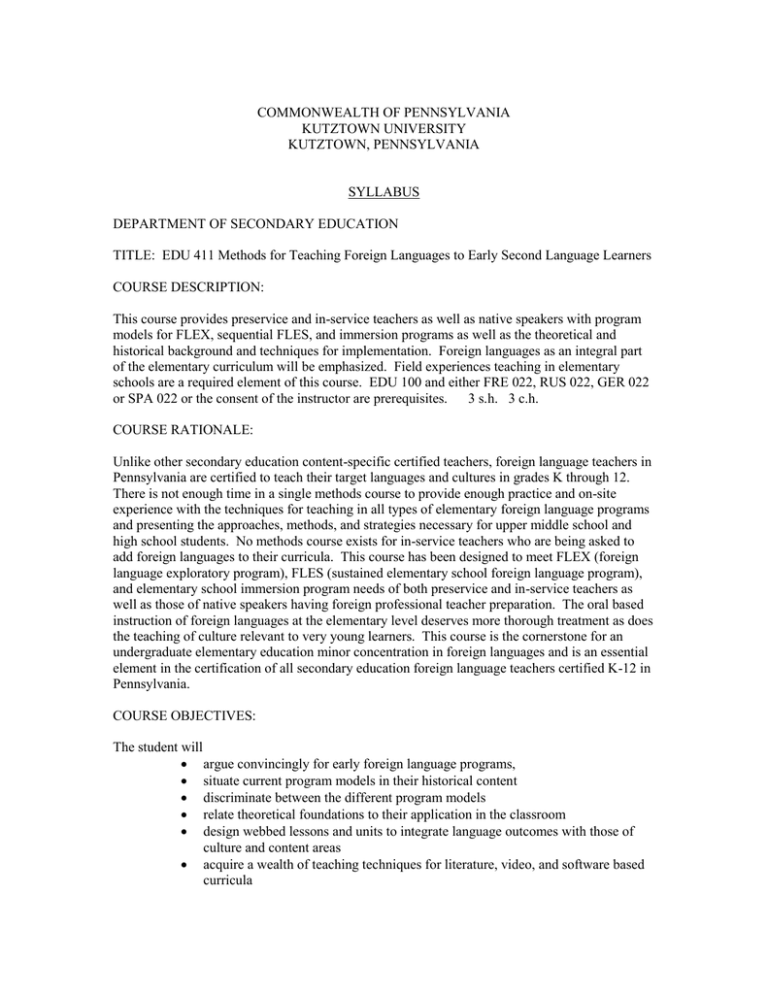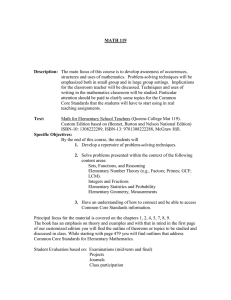COMMONWEALTH OF PENNSYLVANIA KUTZTOWN UNIVERSITY KUTZTOWN, PENNSYLVANIA
advertisement

COMMONWEALTH OF PENNSYLVANIA KUTZTOWN UNIVERSITY KUTZTOWN, PENNSYLVANIA SYLLABUS DEPARTMENT OF SECONDARY EDUCATION TITLE: EDU 411 Methods for Teaching Foreign Languages to Early Second Language Learners COURSE DESCRIPTION: This course provides preservice and in-service teachers as well as native speakers with program models for FLEX, sequential FLES, and immersion programs as well as the theoretical and historical background and techniques for implementation. Foreign languages as an integral part of the elementary curriculum will be emphasized. Field experiences teaching in elementary schools are a required element of this course. EDU 100 and either FRE 022, RUS 022, GER 022 or SPA 022 or the consent of the instructor are prerequisites. 3 s.h. 3 c.h. COURSE RATIONALE: Unlike other secondary education content-specific certified teachers, foreign language teachers in Pennsylvania are certified to teach their target languages and cultures in grades K through 12. There is not enough time in a single methods course to provide enough practice and on-site experience with the techniques for teaching in all types of elementary foreign language programs and presenting the approaches, methods, and strategies necessary for upper middle school and high school students. No methods course exists for in-service teachers who are being asked to add foreign languages to their curricula. This course has been designed to meet FLEX (foreign language exploratory program), FLES (sustained elementary school foreign language program), and elementary school immersion program needs of both preservice and in-service teachers as well as those of native speakers having foreign professional teacher preparation. The oral based instruction of foreign languages at the elementary level deserves more thorough treatment as does the teaching of culture relevant to very young learners. This course is the cornerstone for an undergraduate elementary education minor concentration in foreign languages and is an essential element in the certification of all secondary education foreign language teachers certified K-12 in Pennsylvania. COURSE OBJECTIVES: The student will argue convincingly for early foreign language programs, situate current program models in their historical content discriminate between the different program models relate theoretical foundations to their application in the classroom design webbed lessons and units to integrate language outcomes with those of culture and content areas acquire a wealth of teaching techniques for literature, video, and software based curricula use ready-made teaching resources as well as create their own for oral communication in the absence of elementary school textbooks for foreign languages use assessment instruments for elementary school students teach in elementary school settings and receive an assessment of their performances rate themselves and design plans to meet the competencies listed in the course syllabus as well as the national standards for foreign language proficiency and knowledge of their target culture(s). EVALUATIVE CRITERIA: Students will be evaluated by several in-class presentations, teaching and assessment of early language learners in field experiences, as well as by exams. ASSESSMENT: Assessment of each student’s level of accomplishment with reference to the course objectives will be based upon a subset of the following: Active participation in class and in discussions Textbook chapter summary project Peer lesson critiques Midterm examination Three mini lessons taught in class Creation of three activities which include lesson-based activities and bulletin boards Three lessons taught to school children at one of several sites Final examination COURSE OUTLINE: I. Rationale, History and Program Models A. Justifying Early Foreign Language Programs B. Learning from the Past C. Selecting and Developing Program Models II. Theoretical Foundations, Languages, Content, and Culture A. Relating Theory to Practice B. Learning from Immersion Programs C. Creating a Classroom Environment for Communication D. Drawing on the Whole Curriculum E. Experiencing Culture in the Elementary School Classroom III. IV. V. Planning Curriculum and Day-to-Day Instruction Assessing Students and Program Efficacy Implementing Program Models A. Budgeting B. C. D. Staffing Addressing Other Practical Issues Stocking the Elementary Foreign Language Classroom with Materials and Resources 1. Environment 2. Alphabet 3. Calendar 4. Sayings and Posters in Target Language 5. Cultural Artifacts 6. Reference Materials 7. Picture books, big books, and more books 8. Art supplies VI. Choosing and Creating Classroom Activities: Elements of the Web A. Age and Pace Factors B. Technology or Medium Factor (literature-based, video-based, software-based) C. Personal, School, and Community Resources D. Multiple Cultural Frames of Reference E. Special Needs Students VII. Techniques and Activities for Teaching Language in Context A. Songs (rounds for repetition, refrains, acting out for reinforcement) B. Games C. Role-playing D. Mime (Gouin series) E. Role of Gestures F. Counting and Charting G. Graphs and Venn Diagrams H. Role of Fantasy (the elevator, the airplane, the window box) I. The Line-up J. Rhyme K. Stories (narrative structure, appropriateness, authentic culture) L. Magic Bags, Props and Puppets M. Science Demos N. Total Physical Response Motions O. Cloze Passages P. Dressing up the Animal Q. Weather and Other Posters R. Matching S. Using the Color Wheel T. Making Clocks U. Filling in the Reading the Day and Date V. Sayings W. Teamwork (Pairs, Small Group, Row, etc.) X. TPR for Classroom Commands and Giving and Following Directions Y. Using the Bulletin Board for Cultural Requests Z. Environmental Print for Classroom Requests VIII. Field Experience and Evaluation BASIC TEXTBOOKS: Curtain, Helena and Carol Ann Bjornstad Pesola. Languages and Children: Making the Match. 2 ed. White Plains, NY: Longman, 1994. Shrum, Judith L. and Eileen W. Glisan. Teacher’s Handbook: Contextualized Language Instruction. Boston: Heinle and Heinle Publishers, 1994. INSTRUCTIONAL RESOURCES American Association of Teachers of French National Commission on Cultural Competence (Howard L. Nostrand and Allan W. Grundstrom, Co-Chairs). Acquiring Cross-Cultural competence: Four Stages for Students of French. Lincolnwood, IL: National Textbook Company, a devision of NTC Publishing Group, 1996. Amery, H. The Usborne First 100 Words in French Sticker Book. Tulsa, OK: EDC Publishing, n.d. Amery, H. and Kirilenko, K. The First Thousand Words in Russian. Tulsa, OK: EDC Publishing, 1983. Anderson, A. French in the Elementary School: A Context-based Curriculum. Flint, MI. Atlas dlia malysh (Atlas for Young People) Boujon, C. Lafée au long nez. Paris: L’école des loisirs, 1985. Bovaird, A. E. and Ballouhey, P. Goodbye USA—Bonjour la France! Volume Two. N.p.: Barron’s, n.d. Cataradi l’extraterrrestre. N.p.: Éditions Études Vivantes, n.d. Chacé, C. and Diaz-Bozette, C. Les petits cousins: Comptines francaises et espagnoles. Paris: Didier, 1992. Cole, Joanna. El autobús magico: Siente un inquientante hormigueo. NY: Scholastic Inc. 1996. _________. El autobús magico: En tiempos de los dinosaurios. NY: Scholastica, 1995. de Sauza, J. Brother Anansi and the Cattle Ranch (El Hermano Anansi y el rancho de Ganado. Emeryville, California: Children’s Book Press, 1989. French for Children. NY: Conversaphone Institute, Inc. 1988. González, L. M. The Bossy Gallito (El Gallo de Bodas) A Traditional Cuban Folktale. NY: Scholastic, Inc., 1994. Hadley, A. O. Teaching Language in Context. Boston: Heinle and Heinle Publishers, A Division of Wadsworth, Inc. 1993. Jordan, S. Chansons et jeux francais pour débvutants petits et grands. Niagara Falls, NY: Jordan Music Productions, 1993. Lipton, G. C. Practical Handbook to Elementary Foreign Language Programs (FLES*) Including Sequential FLES, FLEX, and Immersion Programs, 2nd ed. Lincolnwood, IL: National Textbook Company, 1995. (Significantly revised edition to appear in April 1997) Mas, J. Le Calendrier. Guide to The Calendar Package. Don Mills, Ontario: Addison Wesley Publishers, 1995. Mi Familia Siempre Está Contenta. Video-based series for teaching Spanish in context in elementary schools prepared in Pensacola, FL (1995-1996) Montgomery County Public Schools. Miriam Met, project director. Eileen Lorenz, project specialist. Teaching Culture in Grades K-8: A Resource Manual for Teachers of French. Rockville, MD: Montgomery County Public Schools, Department of Academic Programs, Division of Curriculum Coordination and Implementation Foreign Languages, 1994.




